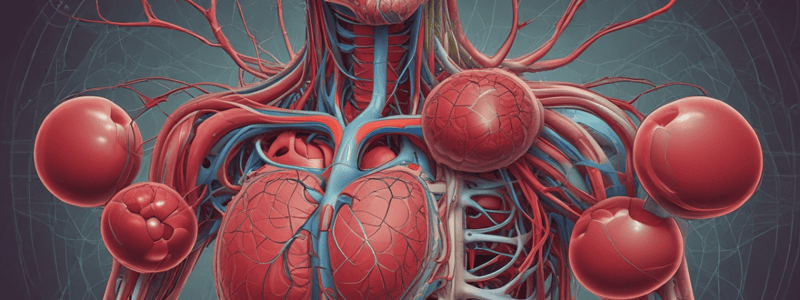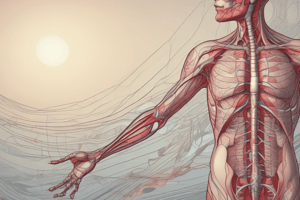Podcast
Questions and Answers
Which of the following is NOT a structure in the circulatory system?
Which of the following is NOT a structure in the circulatory system?
- Blood Vessels
- Lungs (correct)
- Blood
- Heart
What is one of the primary functions of the circulatory system?
What is one of the primary functions of the circulatory system?
- Transporting waste (correct)
- Processing nutrients
- Producing energy
- Filtering blood
Which component of the circulatory system is primarily responsible for protecting against infection?
Which component of the circulatory system is primarily responsible for protecting against infection?
- Blood vessels
- Heart
- Red blood cells
- White blood cells (correct)
What are red blood cells also known as?
What are red blood cells also known as?
How does the circulatory system help regulate body temperature?
How does the circulatory system help regulate body temperature?
What is the function of platelets in the blood?
What is the function of platelets in the blood?
What is the main role of blood vessels in the circulatory system?
What is the main role of blood vessels in the circulatory system?
How long do red blood cells typically live?
How long do red blood cells typically live?
Where are white blood cells produced?
Where are white blood cells produced?
Which type of blood cells are the smallest?
Which type of blood cells are the smallest?
Which cells are primarily responsible for carrying oxygen throughout the body?
Which cells are primarily responsible for carrying oxygen throughout the body?
What is another name for Platelets?
What is another name for Platelets?
Where are White Blood Cells produced?
Where are White Blood Cells produced?
How long do Red Blood Cells live?
How long do Red Blood Cells live?
Which component of blood is responsible for its clotting?
Which component of blood is responsible for its clotting?
What is the main role of physiology in the context of human anatomy?
What is the main role of physiology in the context of human anatomy?
Which concept refers to the state of balance and optimal function of all body systems?
Which concept refers to the state of balance and optimal function of all body systems?
What must a phlebotomist understand about the circulatory system?
What must a phlebotomist understand about the circulatory system?
Which of the following is the correct sequence from smallest to largest making up the human body?
Which of the following is the correct sequence from smallest to largest making up the human body?
Why is it important for a phlebotomist to understand anatomy?
Why is it important for a phlebotomist to understand anatomy?
What is the purpose of related laboratory testing in relation to disorders?
What is the purpose of related laboratory testing in relation to disorders?
What is the main function of the pulmonary system?
What is the main function of the pulmonary system?
Which system is responsible for carrying oxygenated blood from the heart to the body?
Which system is responsible for carrying oxygenated blood from the heart to the body?
Which of the following types of blood vessels is NOT mentioned?
Which of the following types of blood vessels is NOT mentioned?
What role do blood vessels play in the body?
What role do blood vessels play in the body?
What organ system is part of the pulmonary system along with blood vessels?
What organ system is part of the pulmonary system along with blood vessels?
Which of the following is the primary process to stop bleeding and repair blood vessels after injury?
Which of the following is the primary process to stop bleeding and repair blood vessels after injury?
What is the initial response in the hemostasis process after a blood vessel is damaged?
What is the initial response in the hemostasis process after a blood vessel is damaged?
What component forms a stable blood clot if the injury is severe enough?
What component forms a stable blood clot if the injury is severe enough?
Which processes are involved in the dissolution of the clot after the injury is healed?
Which processes are involved in the dissolution of the clot after the injury is healed?
What is a blood clot composed of?
What is a blood clot composed of?
Approximately how long does the coagulation process take?
Approximately how long does the coagulation process take?
Which type of blood vessel connects arterioles and venules?
Which type of blood vessel connects arterioles and venules?
What is the primary function of capillaries?
What is the primary function of capillaries?
Which characteristic is true about arteries?
Which characteristic is true about arteries?
What differentiates veins from arteries?
What differentiates veins from arteries?
Why do arteries need to have thick, muscular walls?
Why do arteries need to have thick, muscular walls?
What function do valves in veins serve?
What function do valves in veins serve?
Which vein carries blood from the lower body to the heart?
Which vein carries blood from the lower body to the heart?
Which statement is true about venules?
Which statement is true about venules?
Which artery is responsible for extending up the right and left side of the neck?
Which artery is responsible for extending up the right and left side of the neck?
Where does the superior vena cava transport blood from?
Where does the superior vena cava transport blood from?
What type of blood do arteries generally carry?
What type of blood do arteries generally carry?
What characterizes a vein as opposed to an artery?
What characterizes a vein as opposed to an artery?
What is the smallest type of artery that attaches to the proximal end of a capillary?
What is the smallest type of artery that attaches to the proximal end of a capillary?
Which artery extends down the center of each arm?
Which artery extends down the center of each arm?
Where does the largest artery, the aorta, connect to the heart?
Where does the largest artery, the aorta, connect to the heart?
Which vein is the first choice for routine venipuncture in the arm?
Which vein is the first choice for routine venipuncture in the arm?
Where is the cephalic vein located relative to the antecubital area?
Where is the cephalic vein located relative to the antecubital area?
Why is the basilic vein considered the last choice for venipuncture?
Why is the basilic vein considered the last choice for venipuncture?
Which of the following veins is NOT typically associated with venipuncture in the arm?
Which of the following veins is NOT typically associated with venipuncture in the arm?
What is the primary venipuncture site area called?
What is the primary venipuncture site area called?
Flashcards are hidden until you start studying
Study Notes
Circulatory System
- Consists of heart, blood vessels, and blood
- Functions: transporting gases, nutrients, waste, and hormones, protecting against infection, and regulating body temperature
Anatomy and Physiology
- Anatomy: the structure of an organism
- Physiology: the function(s) of an organism's anatomy, including chemical and physical processes
- Homeostasis: the state of balance and optimal function of all body systems
Composition of Blood
- Red Blood Cells (RBCs):
- Contain hemoglobin (Hgb) and carry oxygen throughout the body
- Produced in the bone marrow
- Also known as erythrocytes
- Live for around 120 days
- White Blood Cells (WBCs):
- Develop from stem cells that provide immunity
- Produced in the bone marrow
- Also known as leukocytes
- Live from six hours to several years
- Platelets:
- The smallest blood cell
- Responsible for the clotting of blood
- Produced in the bone marrow
- Also known as thrombocytes
- Live for about 10 days
Hemostasis and Coagulation
- Hemostasis: an ongoing process to stop bleeding and repair blood vessels after vascular injury
- Coagulation: a critical component of hemostasis, forming a stable blood clot
- Hemostasis progresses through four responses:
- Vasoconstriction
- Formation of a platelet plug
- Coagulation
- Fibrinolysis
Blood Vessels
- Tubular structures that carry blood throughout the body
- Link together the pulmonary and systemic systems
- Three main types: capillaries, arteries, and veins
Pulmonary System
- Carries deoxygenated blood from the heart to the lungs and oxygenated blood back to the heart
Systemic System
- Carries oxygenated blood from the heart through the body and deoxygenated blood back to the heart
Capillaries
- Exchange oxygen and carbon dioxide between the blood and cells through their thin walls
Arteries
- Carry oxygenated blood away from the heart to the rest of the body
- Have thick, muscular walls
- The pressure exerted on the arteries creates a pulse that can be felt
Veins
- Carry deoxygenated blood back to the heart from the rest of the body
- Have thinner walls than arteries
- Valves prevent backflow of blood
Obtaining Blood Samples
- The antecubital fossa is the primary venipuncture site
- Median cubital vein is the first choice for routine venipuncture
- Cephalic vein is the second choice
- Basilic vein is the last choice
Studying That Suits You
Use AI to generate personalized quizzes and flashcards to suit your learning preferences.




